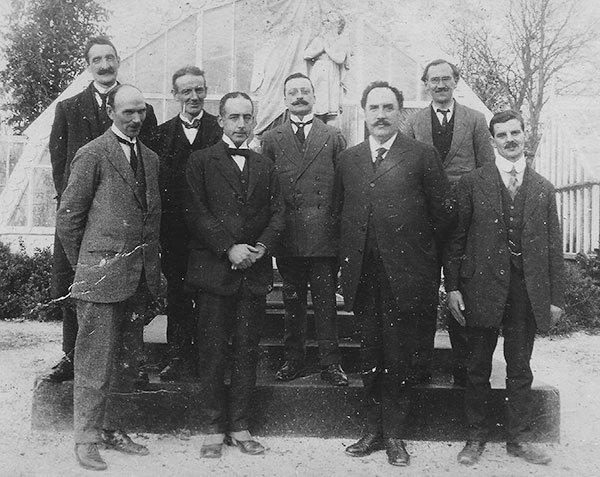James Connolly not Griffith’s best man
Published in Issue 6 (November/December 2017), Letters, Volume 25Sir,—Following your publication of an article by me relating to Arthur Griffith (HI 24.4, May/June 2016), I have been sent the attached undated photograph of Griffith, which gives no location or names. Suggestions are welcome at colum.kenny@dcu.ie. Looking at the photo, I believe that the third person from the left is Seán Milroy and the sixth is Seán or John O’Mahony, both sometime TDs. The location is not believed to be the National Botanic Gardens, Dublin.
On another note, in the course of a related letter (HI 25.2, March/April 2017) I referred to a suggestion that the socialist James Connolly was the ‘best man’ at Griffith’s marriage to Mary (known as Maud or Mollie) Sheehan in 1910. However, since then I have found firm evidence that the person in question was another James Connolly.
Confusion is understandable given that various persons, including Griffith’s close acquaintance Michael Noyk and H.E. Kenny (‘Sean-Ghall’), have testified to a high mutual regard between the socialist and the founder of Sinn Féin. In 1914 Connolly and Griffith appeared together at an anti-war meeting and Connolly then advertised the paper that he edited in one edited by Griffith.
Connolly was back in Dublin from America by late 1910 and collaborating with a Griffith admirer, Maud Gonne. However, parish records show that the James Connolly who witnessed Griffith’s marriage resided at 63 Whitworth Road. The 1911 census shows that this person was aged 29 and had been born in Antrim, and that he worked as a civil servant at the Four Courts. He was in fact the same person recalled in Seán T. O’Kelly’s statement to the Bureau of Military History (WS 1,765):
‘There was another group with whom Griffith was on terms of easy friendship and intimacy. With these Griffith relaxed more than with anyone else, and the basis of their friendship was, of course, first of all their Irish-Ireland outlook and their support of the movement for complete independence, and in addition; literary tastes. The chief of these would be “Seamas O’Sullivan”, whose real name was James Starkey, who was a pharmaceutical chemist, but who gave all his time to literature; Dr. Oliver Gogarty, as would also be James Stephens who was then a Law Clerk in Dublin, and who contributed regularly to the United Irishman and later to Sinn Féin. Dr. Joseph Boyd Barrett, Mr Nolan Whelan, B.L. and Mr Michael Noyk, Solicitor. One other I should mention would be James Connolly (elder brother of Joseph Connolly, afterwards Minister in Mr deValera’s Government), who was then a clerk in the Four Courts, and a regular contributor to Griffith’s paper. With some of that group Griffith would meet a couple of nights or maybe three nights a week.’

The clerk Connolly is sometimes referenced under the forms Séamus Ó Conghaile and Séamus [O’]Connolly. As early as 1904, when the socialist Connolly was living in America, we find a ‘James Connolly’ writing about theatre and literature in Griffith’s United Irishman (e.g. April–June 1904, 27 Oct. 1906). Either of the two men may have composed the poetic lament for William Rooney that appeared in that same paper on 23 September 1905 (the socialist then in America tried his hand at a similar style of verse). Griffith’s close comrade Rooney had died suddenly, with Maud Gonne comparing his influence on young people then to that of Thomas Davis earlier.
Seán Ó Lúing (Ó Gríofa, 134, 168) has described the Four Courts clerk James Connolly as ‘fear mór graiméir agus díospóireachta’, and Padraic Colum (Griffith, 94) deemed him ‘a pundit if ever there was one’. While a question may remain as to whether or not he was the only person who contributed to Griffith’s papers under the name James Connolly, there can be no doubt that it was the clerk from County Antrim who was Griffith’s best man.—Yours etc.,
COLUM KENNY
















